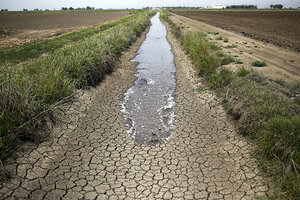Food costs up, energy costs down as inflation rises slightly
The Bureau of Labor Statistics announced Tuesday that the Consumer Price Index rose 0.1 percent in July. One of the major drivers of the inflation increase was rising food prices, but they were offset by a dip in energy prices.

Irrigation water runs along a dried-up ditch between rice farms in Richvale, Calif. on May 1. In Santa Cruz, Calif., dozens of residents who violated their strict water rations take a seat at Water School, hoping to get hundreds of thousands of dollars in distressing penalties waived. California is in the third year of the state's worst drought in recent history.
Jae C. Hong/AP/File
You've probably noticed you're spending more at the grocery store.
According to report released by the Bureau of Labor Statistics Tuesday, the Consumer Price Index (CPI) increased 0.1 percent in July, the weakest growth since February. One of the biggest factors was food prices, which increased 0.4 percent in July.
The monthly increase was small, but drought and disease have pushed food prices to historic heights over the past year or so. Since July 2013, the price of meat is up 9.3 percent. Dairy goods increased 4.3 percent from last July, and fruits and vegetables are up 2.0 percent.
The US Department of Agriculture warned about the problem in June, saying, "the ongoing drought in California could potentially have large and lasting effects on fruit, vegetable, dairy, and egg prices, and drought conditions in Texas and Oklahoma could drive beef prices up even further."
Chris G. Christopher, director of consumer economics at IHS Global Insight, said in an e-mail, "Overall, the consumer inflation story is relatively mild. However, the direction of food prices is somewhat worrisome. Lower and middle income households are likely to be paying a larger percentage of their paychecks for grocery bills."
Mr. Christopher added that household incomes, when adjusted for inflation, are 8.4 percent below 2007 levels, and that 15 percent of Americans live below the poverty line. "The rise of food prices makes it more difficult for many Americans households – especially those households that live paycheck to paycheck," he said.
Families aren't the only ones feeling the impact of rising food prices, Joshua Shapiro, chief economist at MFR, Inc. wrote via e-mail. "[A]n income-constrained, price sensitive consumer is making life difficult for restaurants and fast food establishments, who are having to absorb a portion of the acceleration in food prices." Not all companies could continue to absorb the rising cost of food. Chipotle cited the rising cost of beef, avocado and dairy when it raised prices 6 percent this spring, according the Monitor. California-based In-N-Out burger raised its prices, citing rising food cost.
The BLS reported some relief for families and businesses. The cost of energy was down 0.3 percent in July. In an even bigger drop, the cost in airline fares fell 5.9 percent in July.
Michael Feroli, chief US economist for JPMorgan Chase & Co., told Bloomberg that if inflation continues to increase slower than the Federal Reserve's target, will give the central bank room to keep interest rates low until the end of the bond-buying program in October.
“Some of the inflation concerns that you were hearing back in June will probably ease off a little bit,” Mr. Feroli said. “It takes some pressure off the Fed to speed up rate normalization. There had been a lot of rhetoric about the Fed being behind the curve on inflation, and this probably takes some wind out of that.”

